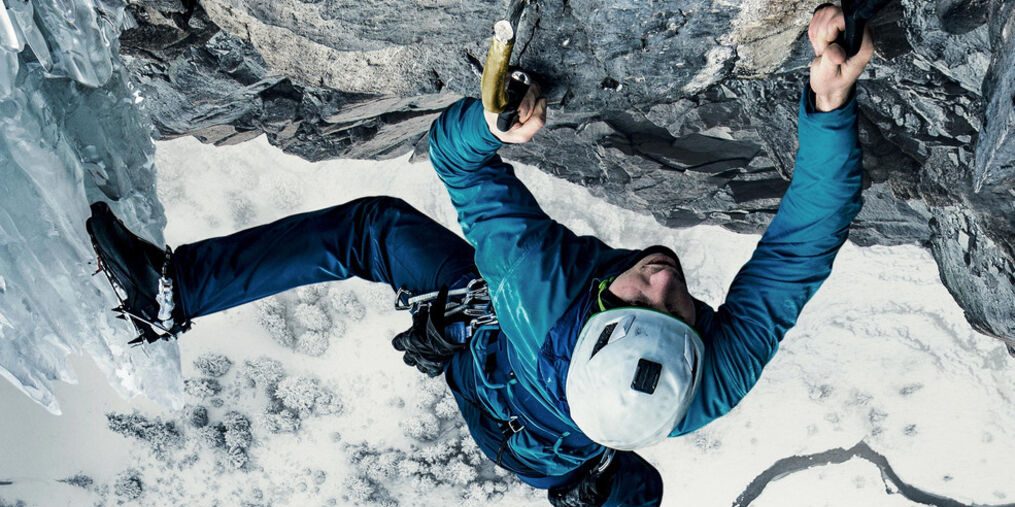Having a human rights commissioner who is conversant in the debates about human rights and Islam can only benefit Alberta Muslims.
The Psyche of the Mountains
Alpinism does not happen in the gym. It does not happen online. It happens in the mountains. Mountains are indifferent to the little featherless bipeds who scratch and grasp their way up seams of rock and ice. You might not know this from the recent explosion of popular interest in the world of climbing. Spurred on by social media and films like the Oscar-winning Free Solo, the world of climbing mountains has become a competitive spectator sport. One can climb today without any sense that death often comes thieving for the young mountaineer.
And yet alpinism is not dead. The life of the Canadian alpinist Marc-André Leclerc, documented in the beautiful cinematography of The Alpinist, takes us as close to the joyous freedom of the hills as we can get without crampons and the possibility of death.
The documentary begins with footage of Leclerc “free soloing” (climbing without ropes) the North East buttress of Mount Sleese in British Columbia. Except that a key thesis of the film, indeed a key thesis of Leclerc’s philosophy, is that this is not footage of free soloing. The scene is offered with commentary by Alex Honnold, the star of Free Solo who made the audiences and filmmakers hold their breath as he scaled El Capitan in Yosemite National Park. Honnold is asked “who impresses you right now?” He answers, “This kid Marc-André Leclerc, Canadian guy,” and then when the interviewer notes that he will upload footage for his audience later, Honnold notes “one of the interesting things about Leclerc is that I don’t think there is video of most of the things he’s doing…he’s just going out and climbing for himself in pure style.” The contrast with Free Solo, a film that is as much about filming Honnold’s “free solo” of El Capitan as the climb itself, is present throughout The Alpinist.
In one of the most enjoyable parts of the film, Leclerc makes it clear that there is a difference between climbing for the cameras, for an audience, and pure alpinism. Once the film documents Leclerc’s early life growing up as a wild child in the shadow of British Columbia’s coastal range, it turns to the way his climbing career blipped sporadically on and off the public’s radar. After pulling off several incredible feats of mountaineering, including “free soloing” three mixed climbs (climbs with both rock and ice) on the Stanley Headwall, Leclerc found himself becoming a professional climber with his first sponsorship by Arc’teryx. By this point he was already the subject of the documentary, and The Alpinist’s filmmakers narrate how “as we were planning the next shoot, Marc just suddenly dropped off the radar.” The filmmakers started to see Leclerc “showing up in other climbers’ social media posts.” The film moves from images of the filmmakers pulling their hair out as they try to reach Leclerc on his cellphone, to shots of Leclerc clinking beers and grinning in the social media posts of other famous climbers. He is glimpsed going on adventures to Baffin Island and Alberta’s Ghost Valley with his girlfriend and climbing partner, Brette Harrington.
And then the filmmakers learn that Leclerc had completed the first free solo of the “Emperor Face” of Mount Robson. No rope. No drones. No film crews. Only a “selfie” at the summit as a nod to the modern world. Barry “Bubba” Blanchard, the dean of Canadian alpinism with the flowing hair of a samurai, narrates Leclerc’s achievement for the audience:
Robson is the king. It’s the highest mountain in the Canadian Rockies. It’s like three El Caps. But Robson is not Yosemite. It’s got glaciation, it’s got crevasses, it’s got avalanche. You’re climbing rock, ice, and snow, all at the same time. It’s a legendary, mythical objective—even with a rope.
Barry would know; he put up the first ascent of the route Leclerc chose, Infinite Patience, roped up to Eric Dumerac and Phillipe Pellet in 2002. The filmmakers were supposed to be making the alpine sequel to Honnold’s Free Solo and their main character decided to complete the main act without them. They were understandably annoyed. They film themselves reaching out in their frustration to Leclerc as he blithely explains that “I’ve never let you guys actually come and shoot one of my real solos.” When asked “why not?”, he replies:
It wouldn’t be a solo to me if somebody was there.
And with that, the glaze begins to fade from the filmmakers’ eyes as they grapple with the truth in Leclerc’s words. They are trying to film something that cannot be filmed. Leclerc agrees to allow them to film him “free soloing” Infinite Patience a second time. As we watch him hack his way through the gargoyles of snow that guard the summit, we are squarely confronted with the knowledge that this unrivalled performance is a mere imitation of the real adventure.
Hump the Sky
It’s easy to slip into hagiography, technobabble, or geology when talking about alpinists. Even the grumpiest and most personally flawed mountaineers often have their vices celebrated and sanctified as part of what made them so good at climbing. Fred Beckey probably left his climbing partner to die of cerebral edema at 23,000ft on Mount Lhotse and he is still (probably rightly) celebrated as one of the greatest “dirtbag” climbers of all time. Alpinists, particularly males, can sometimes barely stand to speak about anything that isn’t related to climbing grades, gneiss formations, etc. After Alex Honnold completed the first “free solo” of El Capitan in Free Solo his girlfriend tells him she loves him and he haltingly replies: “Love you, thank you so much.” My wife and I burst out laughing at that interaction. These tendencies can distort our understanding of alpinists as human beings.
Perhaps the reader who has not seen the film is imagining Leclerc as a latter-day monastic, or a technically tongue-tied and emotionally challenged wanderer. Alternatively, if all you knew about Leclerc was that he free soloed Mount Robson, then you might imagine a burly man with a square jaw and glowering countenance. Perhaps you are imagining the Reinhold Messner, who appears in the film to grimly note that “If death was not a possibility, coming out would be nothing. It would be Kindergarten.”
In the first scene where we hear Leclerc speak, he is jumping on a trampoline behind a “dirtbag donuts” stand in Squamish, British Columbia. He bounces on his back and tells the interviewer “this is called a sky hump into a front flip.” He then executes the “sky hump” with aplomb and bursts into laughter. This is just the first of many scenes that offer the audience a delicate aftertaste of the fun and adventure that make mountaineering so enticing. Everyone who has been on a mountain adventure of some kind, or even just imagined such a quest, will feel spiritual alpenglow as they watch this curly Canadian bound through the wilderness.
After all, solitude is not unique to the mountains. You can be alone in a crowded city or on a mountain top. But even when Leclerc is alone, for example on the first winter solo climb of the Torre Egger in Patagonia, he makes short videos for Brette.
The Alpinist also makes it clear that Leclerc was in love with more than just rocks and ice. At the heart of the narrative is his relationship with two women: his mother, Michelle Kiupers, and his girlfriend Brette Harrington. These women show us a great deal about Leclerc’s spirit.
His mother, Michelle, helps us to understand why Leclerc seems unable to sit still or look directly into the camera: he is not comfortable with the stillness, the objecthood, the falseness that comes with explaining his life as though it was already over. She tells us about how formal schooling became a kind of prison for him, and so she homeschooled him and encouraged his love for the outdoors. He was drawn to alpinism for the purity of the thing itself, and his mother led him to that ethic. And that is a rare thing these days.
The world of climbing is becoming more of a spectator sport, with all the corrupting politics and consumerism that it brings. There are now climbing competitions conducted for crowds at the Olympics. Companies like Patagonia sponsor absurd social justice propaganda, while high-profile climbers preen themselves with woke activism. Alpinism has always been politicized and it has always featured competition and big egos: think of Heinrich Harrer and the Aufschnaiter expedition to Naga Parbat. The purity Leclerc sought in alpinism had little to do with such vanities.
His girlfriend, Brette, gives the filmmakers and the audience insight into how Leclerc was not merely pretending to be shy of the limelight. His priorities lay elsewhere. After Leclerc slips off the radar she explains: “I think it’s cool that you’re making a movie about Marc. But, honestly, he doesn’t care about movies.” And even more importantly, her relationship with Leclerc seems to underline how his conception of adventure was never about merely seeking solitude.
After all, solitude is not unique to the mountains. You can be alone in a crowded city or on a mountain top. But even when Leclerc is alone, for example on the first winter solo climb of the Torre Egger in Patagonia, he makes short videos for Brette. Bivouacking on the side of Torre Egger, his smile is illuminated by his headlamp as he says that “there’s a part of me that wishes I could just quickly rap to the ground and get out of here, and change my flights, and come back and see you, cos I’d love to, yeah, just see you.” Perhaps he was questing to bring little pieces of life back to his loved ones, like a knight-errant. Whatever Leclerc was seeking on his solo climbs, it was not the same attempt to escape life that has driven others to flee civilization. Leclerc’s relationships help show how he was quite different from Christopher McCandless, the tragic real-life protagonist of Into the Wild.
Psyched
When climbers, particularly North American climbers, speak among themselves they often slip into their own dialect. Some of their slang is intentionally silly and some of it is beautiful, and some deserves to be purged from all English-speaking tongues. One of the most interesting terms in this patois of the peaks is the word “psyched.” Climbers often use this word to mean that they are excited, energetic, and ecstatic to be climbing, or brimming with these emotions at the very prospect of climbing. Leclerc uses the term at several points in the film. The word might sound jarring to some, but on Leclerc’s lips it rings with the vibrancy of its Greek roots. Psy-chē. The soul. And even his fate could not bury that.



